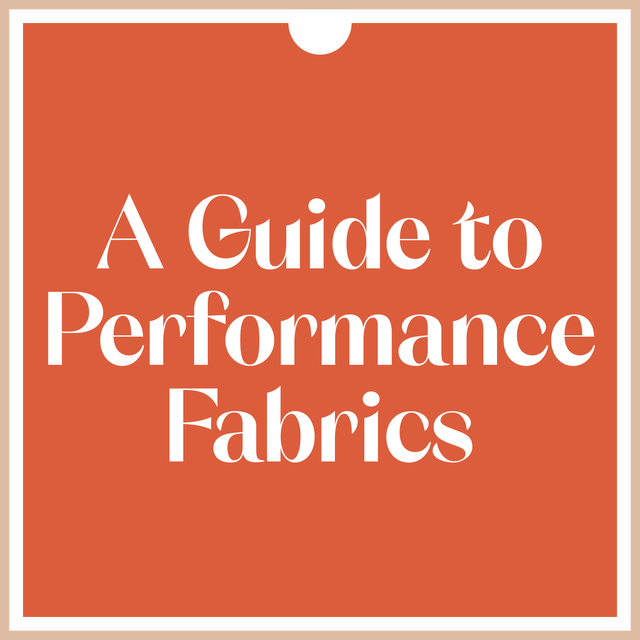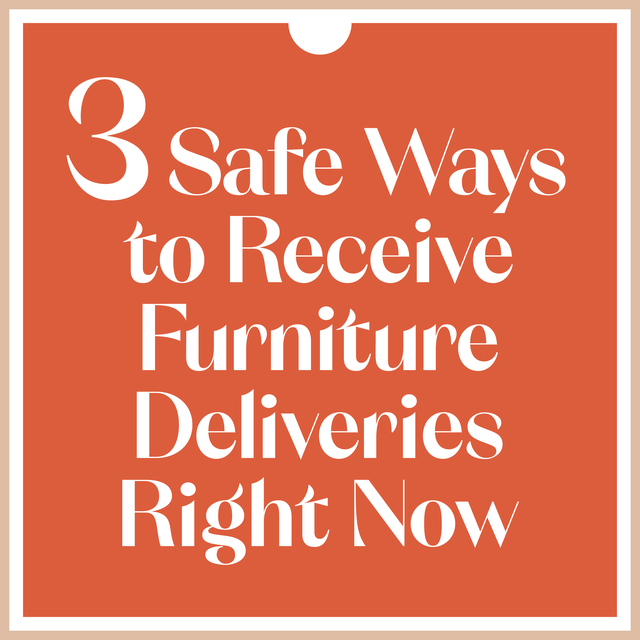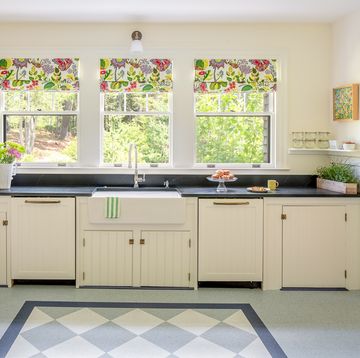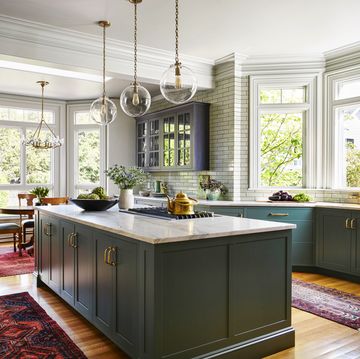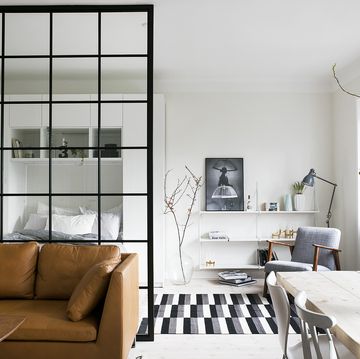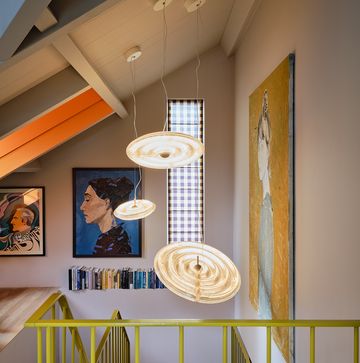A new sofa is a purchase that no one makes lightly. It's an investment! And something you'll be using almost every day. "Your sofa is a big piece that will define your space," says designer Suzanne Kasler. You probably already have a style in mind that you like, but, if you've never bought a couch before—or if you've found yourself regretting past sofa purchases—you might be looking for a little direction. This guide will help you find a sofa you'll love for years to come (and one that will last as long, too!).
Scroll down, or click to head right to the section you're looking for. (And if you're too impatient to read all this, just start shopping our favorite sofas of 2020.)
- What Makes a Well-Constructed Sofa?
- Buying the Right Sofa for You
- Shopping for a Sofa the Smart Way
- Caring for Your New Sofa
What Makes a Well-Constructed Sofa?
A lot of materials are required to make a sofa, and some are better than others—at least when it comes to longevity. A sofa with a particle-board frame and all-foam cushions might be the most affordable option, but it won't necessarily be the longest-lasting sofa you can buy. (And maybe that's fine by you!) A higher-quality sofa, on the other hand, will have the following construction.
1. A Wooden Frame
This is key to a well-made sofa, but there are different frame factors to consider that that can impact durability.
Make sure it's kiln-dried.
"All kiln-dried means is that the wood is placed in an oven and dried to the point that it only has about a seven to eight percent moisture content," Luther M. Quintana, the Operations Manager at Luther Quintana Upholstery, Inc., tells House Beautiful. "Air-dried wood can miss that seven to eight percent metric, thus leaving the wood more prone to shifting and warping. Wood with low moisture content is the best for furniture."
Choose either solid hard wood or engineered wood.
Bob Williams, President of Design and Co-Founder of Mitchell Gold + Bob Williams, says that hard wood or engineered wood are both great options. Hard wood is pretty straightforward: It's solid and makes for a sturdy frame. Engineered wood, on the other hand, is essentially "taking a tree and turning it into engineered plywood so that there's less waste material," Williams explains. "It does make a very, very strong frame because of its cross banding. They can cut it in and hook it together, so you get a lot of reinforcement that way. And then, any scrap that's left over gets recycled."
Don't forget about the joinery.
Then there's the way a sofa is put together. Frames are usually doweled, stapled, glued, or some combination thereof, and they use corner-blocking to be extra sturdy. At Arhaus, for instance, you can see how these different methods work together. "Frames are held together by a combination of long-buried staples that are coated in water-based glue," explains TJ Schmitz, the brand's Senior Vice President of Product Development. "The force at which those staples are shot into the wood frame produces enough heat and friction to melt the glue—creating a better, stronger bond. Then, the frames are corner blocked in all corners, and braces are added through the length of the frame."
How the legs are attached is also important, says Samara Tuchband, Crate & Barrel's Vice President of Merchandising. "Look for a sofa with legs that are either part of the frame, or wooden dowels attached by metal screws and brackets," she explains. "The sturdier the frame, the more likely your sofa will last longer."
2. Good Suspension
Every sofa has a suspension system (either coils, webbing, or ties, according to Tuchband), and it's key to both your sofa's quality and your comfort. Two of the most popular—and most comfortable—systems experts recommend are eight-way hand-tied and sinuous spring.
- Eight-way hand-tied: "If you want the 'gold standard' of systems, look for eight-way, hand-tied springs that are handcrafted to support your every move," Tuchband says. Quintana agrees that these are "the best." An eight-way hand-tied suspension simply means that the springs have all been individually tied in every direction. "The weight distribution is much better when the coiled springs are tied together using jute twine," Quintana adds. Eight-way, hand-tied sofas are also the most expensive because they're the most intricate.
- Sinuous spring: Quintana describes sinuous springs as a lighter, cheaper alternative that can still work well when done right. "In this system, a series of thick metal wires are fastened to the sofa’s wood frame to provide support," Schmitz explains, noting that it's one of the most popular suspension systems in the industry now. "Sinuous wire suspensions with S-shaped coils placed close together distribute weight more evenly, providing a more comfortable sofa," Tuchband says.
3. Comfortable Cushions
A well-made frame and suspension are needed to give a sofa a great foundation, but if you don't have comfortable cushions to top the whole thing off, you're not going to love lounging on it.
In terms of material, Quintana says that Dacron-wrapped foam cushions are the most widely available but not necessarily the most comfortable. On the other hand, 100-percent down is super luxurious and comfortable, but you tend to sink right into it—and sometimes that makes it harder to get back up. That's why he recommends going with a combo instead of choosing one or the other.
"I would use a mix of materials," Quintana says. "For example, a soft or medium density foam core, wrapped in an 80/20 down/feather mix. This is the best of both worlds, as you have the 'give' of down and the durability of a foam core."
Williams agrees, noting that the most popular, best-selling cushions at Mitchell Gold + Bob Williams are a Dacron-wrapped, high-density poly foam that is then covered in a down-proof ticking casing.
There are, of course, different cushion styles to choose from, and those affect your comfort, too—though they're more of a personal choice than a quality concern (more on that here). And this brings us to the what's most important besides quality, and that's how to buy a sofa that truly suits you.
Buying the Right Sofa for You
Aside from how it's made, the two most important things to consider when you're shopping for a sofa are your lifestyle and scale. You don't want to buy a sofa just because you like the way it looks; you want to get one that's comfortable and well-suited to how you intend to use it.
1.Choose Features that Suit Your Lifestyle
Designer Ariel Okin says to start by asking yourself how the sofa will be used. "Is it going in a formal living room where entertaining is primarily happening with adults, or a playroom where kids will be bouncing all over it?" she asks, noting that the answer will impact the kind of couch you want to buy.
Then factor in who will be using it, too."Obviously you want to consider your children and your pets, but something that people forget is their lounging style," designer Mikel Welch tells House Beautiful.
"If you're somebody who likes to sleep on your sofa, you're probably going to want to opt for a feather down, as opposed to all foam, because if you're constantly sleeping on that sofa, those cushions are going to give and you're going to be very upset with yourself—and I'm a sofa-sleeper, so I know," Welch says. You'll also want to think about what fabric you use in this case: "You're going to want a fabric that's going to repel moisture and oils. And you're going to want to stick to darker colors with a nubby material that will hide soils and stains."
Keep all of this in mind as you pick out the cushion style, fabric, and overall look you want. Coupled with the sizing of the piece—you might want a sectional if you have a big family or love to lounge, for instance, or you might live in a smaller space and need an apartment sofa (or loveseat) to make it work—this will lead you towards a purchase you love.
Cushions
When it comes to comfort, style matters as much as materiality. You'll find that sofas come with either a tight seat or loose seat (and same with the back cushions).
- Tight Seat: If the seat is all one long cushion, that's considered a tight seat or a bench seat. "These are good for desks and dining seating, like chairs or banquettes," Quintana says. "Tight seats are also great for entertainment and conversing as well as you have to sit more upright." Williams notes that tight seats are the most firm option, and Schmitz says that while bench seats like this are pleasing to the eye, they do tend to wrinkle more due to the more expansive length of fabric.
- Loose Seat: If the seat cushions are separated (two-seaters and three-seaters, for instance) then that's considered a loose seat or back. "Loose seats are most comfortable when used in a living room or family room setting," Quintana says. "They're great for lounging and relaxing." Williams echoes this, saying that two-seaters are the more popular choice.
The same applies to the back cushions, Quintana says. "Tight backs are more widespread in use, but a good loose-back, loose-seat sofa is heaven on earth in terms of luxury and comfort."
The depth of your sofa is also very important to consider. "Specifically look at the sofa depth—the deeper, the more relaxing the sofa," Kasler explains. (The deeper, the more room you'll have to sink back into your seat or spread out when reclining.) "In general, the larger the seat cushion and deeper the frame, the better a sofa is for lounging," Schmitz says.
Fabric
If you don't have pets and kids or you're not prone to spills, then you can really have a sofa in just about any fabric you want. But, if you want your sofa to hold up well for years to come, you might want to consider sticking with more durable fabrics that are easy to clean and that hide wear-and-tear better. Even if you don't have a dog or a cat, think about it: A fabric that can hold up to pets can also likely hold up to whatever else life throws at it—and if you're going to spend years hanging out on this couch catching up on Netflix, you probably want it to be able to hold up to everything from spills to snags.
Generally speaking, Okin suggests going with a performance fabric. "Performance fabrics are so durable these days, clients don't really need to worry about having a white or ivory sofa anymore, which makes the purchase even more regret-proof," she says. Schmitz agrees. "The technology behind these fabrics has come so far, you can now have a light grey, cream, or white sofa without having to worry!" he says. So if you've always dreamt of a crisp white sofa, a performance fabric is definitely your best bet.
If you like the look of slipcovers, Schmitz notes that washable slipcovers are also always a good idea. "They're easy to wash, and always look clean," he says. "Plus, you can buy multiple slipcovers to refresh your look every season."
Leather is another great option if you want a sofa that's easy to clean, since you can simply wipe it down, making it a good pick for those with kids and pets—just, not pets that are prone to scratching. (Sharp nails and leather don't really mix, per Schmitz.) Woven fabrics, which have texture and even subtle patterns—like what Welch described above for sofa sleepers!—are great for pets as well, because they hide stains better and can even disguise pet hair and scratches.
Other pet-proof furniture fabrics include low-pile fabrics like microfiber or synthetic velvet. In an interview with House Beautiful last year, Lauren Cox, the Design Program Manager at Havenly, explained that fabrics like these have less material to trap odors with, so if you're worried about your sofa retaining any weird smells, they're a good option for you. Cox also suggests using outdoor fabrics indoors (yes, you can do that!) if you're really worried about them holding up, since they're already made to stand up to inclement weather.
Style
The style of the sofa you pick may not have any bearing on how long it lasts, but, as Kasler says, "You will want something that you can see yourself liking for many years and also, that will fit aesthetically with your things in your space." You don't want to buy a sofa just because it's super trendy, unless you have the budget to be replacing your sofa every few years.
Both Kasler and Okin advise going with a classic silhouette and a neutral color palette, so you never get sick of it. "Sticking to a neutral palette, performance fabrics and classic silhouettes—think: a down-filled English roll arm sofa, upholstered in a cream performance fabric—always lends itself to a timeless choice that never goes out of style," Okin says.
And if simple isn't the look you're going for, Kasler suggests adding personality in other ways. "I recommend getting a sofa in a neutral color so that it's easy to live with, and then add color and pattern with throw pillows and throw blankets." And if you have the space, you can always add a smaller-scale item in a bold pattern, like a loveseat (Kasler says that's the only time she ever does a sofa in a pattern) or even an accent chair.
2. Take Measurements to Ensure It Fits
You could find the most stylish, comfortable, and well-made sofa in the world, but if it doesn't fit in your home—and within the look of the room itself—all that really doesn't matter.
"You don't want to have to call the Couch Doctor to come cut your sofa in half just to fit it in your place," says Welch, pointing to the New York City-based company that arrives to saw sofas in half so they can be fit into a stairwell or elevator bank or doorway (and then, of course, patches them back up).
Whether you're buying a sectional, a traditional sofa, or a loveseat, make sure you get these measurements, according to Schmitz and Williams:
- The sofa's length
- The sofa's width
- The sofa's height
- The sofa's diagonal measurements
- The pitch of the sofa (the angle of the back)
- The length of the legs, and if they unscrew or not
- The width and height of any doorways it will need to pass through
- The ceiling heights in your home
- The width of the stairs, if it needs to go up them
- The measurements of any sharp turns you may have to make on the way
Getting the piece into your home is important, but so is ensuring that it looks right once it's in there—and not just so you can avoid ending up like Ross in Friends, either. "You want something that will fit well in your space, and that has good scale," Kasler says. Okin agrees: "Measuring your room and checking to ensure the scale of the sofa fits the intended space is always step one."
Scale refers to how large or small a piece looks in relation to other furnishings in the room, and here's an easy way to make sure your future purchase is the right scale: "Try taping the sofa out with blue painter's tape at home in the room it will go in—you can accurately check scale that way!" Okin suggests. Step back from the tape and take in a view of the room—is the sofa dwarfed by its surroundings, or far too large in relation to them, or just right?
Shopping for a Sofa the Smart Way
Whether you're planning to shop for a sofa at a local store or are ready to dive in to the world of online furniture shopping, follow these tips to make sure you end up with a sofa you love.
How to Properly Test Out a Sofa In a Store
Don't just sit on it.
"Obviously, the sit-test is very important," Williams says. "Is this sofa comfortable? Check the depth and the length, is it good for you, are you comfortable? The cushions—do they feel good?" And make sure you also lay down on the sofa—or test out your favorite lounging position—as well as sit on it.
"A lot of people may think, oh well, the sofa is just to sit on," Williams adds. "No, a sofa is certainly made to sit on, but it's also made to sleep on. It's made for the lounge. You can sit and have a conversation, or you can sit and watch a movie. And those are two very different things. They are very different positions—just try to lounge on a sofa that's really made for sitting up straight, and vice versa."
You can also check the quality of the foam in a seat while you're in the store, Tuchband explains. "An easy way to determine the quality of foam used in a cushion is by placing and pressing your hands in the middle of a cushion. The closer your hands get to each other indicates the quality of foam used. You want foam that’s soft enough for a comfortable sit, but firm enough so you don’t feel the seat deck underneath."
Ask questions.
When you're buying in person, you have the opportunity to ask a sales person all of your burning questions about the sofa, so do! "Sofas are a big purchase, so don’t be afraid to ask lots of questions!" Schmitz says. His suggestions? Ask about things like the construction, the materials, and the required care and maintenance.
- What are the cushions comprised of?
- What is the content of the fabric?
- What type of leather is used?
- How do I clean this piece?
- What is the warranty?
Williams also suggests asking if the sofa is environmentally safe, if the wood is kiln-dried, what the suspension is, and more, adding that, "The less information you get, or the less detail, the more suspicious you should be." You want to feel confident in your purchase, so make sure that you ask all the questions on your mind and that you're getting the answers you need and feel good about.
How to Score a Quality Sofa Online
- Look for telling terminology. This is where knowing how a quality sofa is made comes in handy. "If you’re unable to test out a sofa in person, we suggest focusing on the descriptions of the frame, suspension, and cushioning," Tuchband says. So, look for the terminology above—kiln-dried hard wood, eight-way hand-tied springs or sinuous springs, and the different cushion materials—and you'll at least know what you're getting, even if you can't see it IRL first. (And ask their customer service via email if you can't find all the details.)
- Check the brand's policies and delivery options. You want to know about any warranties on the sofa, the return policy (just in case!), as well as how the piece will be arrive. "Another detail to check is: Can this be delivered into my space?" Williams says. "You need to read between the lines. How is it going to be delivered? And when it gets delivered, what exactly are you getting? Are you getting something that you have to put together?" You don't want it to arrive only to be surprised that they won't actually be carrying it up the stairs into your space, or that it comes in parts and is super-complicated to put together—it's important to know what you're getting yourself into.
- Read the reviews. "Treat the reviews like Yelp," Welch says. "Read what the reviews are saying, and believe what they're saying," he advises, noting that he prefers to shop on sites that allow reviewers to share photos of their purchase, since that allows you to see what it will look like in a real-life space.
- Research the manufacturer. If you're buying from a brand that manufacturers its own furniture, then you know where it's coming from. But if you're browsing a big-box retailer, do your research. "I encourage people to go online and try to see who the actual manufacturer is," Welch says. "A lot of times, on those websites, you can see the vendor's name." Researching the manufacturer will likely give you more info on how your sofa is made, and can help you determine if it's the one you want in the first place.
Whether you buy online or in person, Okin says that it's worth it to spend extra on the sofa features you love. "Most people spend the majority of their time at home on their sofas and in their kitchens, so these are the areas where it makes sense to make an investment in comfort," she explains.
Caring for Your New Sofa
If you're going to put all of this effort into buying a sofa you love, then you're also going to want to ensure that you're taking proper care of it. The better you maintain it, the longer it will last—and considering how expensive sofas can be in the first place, taking care of your investment is especially important.
How Long Will a Sofa Last?
You've likely heard that a mattress should last at least seven to eight years, but preferably 10. And you're probably wondering about your sofa—will you be buying a new one on a similar timeline? The answer isn't so cut and dry, because there are more factors to consider.
"Your sofa’s lifespan will depend largely on how you live, how many people are in your household, and the quality of the sofa you purchased," Schmitz says. "A high-quality sofa that’s been well taken care of could last for many, many years—even long enough to pass down!"
Rather than focus on a number, you'll want to look at how the sofa itself is holding up. Some signs that it's time for a replacement: Williams says you'll know "if you're sitting on it, and you're sitting through it because the springs are broken; if the cushion is so flat, you can't fluff it up anymore; or if the sofa just looks bad."
Maintenance Tips From the Pros
Again, taking good care of your sofa is key to making it last as long as possible. And the good news is, doing so isn't all that difficult. There are three main things you should be doing to keep your sofa in tip-top condition:
- Vacuum your sofa regularly. When you vacuum your floors, it's a good idea to also vacuum your couch to keep the upholstery clean. Plus, as Williams notes, vacuuming your sofa makes it feel fluffy and clean—which makes sitting on it even nicer.
- Flip the cushions monthly. Both Williams and Schmitz agree that regular cushion rotating is important, and Schmitz recommends doing so on a monthly basis. Similar to rotating your mattress it helps the cushions wear evenly over time.
- Do annual cleanings. How you clean your sofa depends on the sofa you buy, especially since different fabrics require different cleaning methods. Regardless, giving your sofa a good clean once a year can help extend its life, according to Schmitz.
Follow House Beautiful on Instagram.
Brittney Morgan is a noted land mermaid and a Virgo with a penchant for crafts, red lipstick, and buying way too many throw pillows. Her work has also been published at Apartment Therapy, NYLON, HuffPost, Hello Giggles, Elite Daily, and more.







